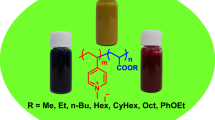Abstract
Amphoteric macromolecular (AM) dyes with different degrees of substitution were synthesized by grafting a poly(acrylamide-co-vinylamine) oligomer with reactive dye. Solution properties of these AM dyes were measured as functions of pH, salt content, the degree of substitution, and concentration of AM dye solutions. The results of the potentiometric and conductometric titrations showed that the first transition at pH ∼10.5 corresponds to the onset of protonation of primary amino groups of AM dyes. and the second transition at pH ∼2.5 corresponds to the end of protonation of the primary amino groups. The results of the solubility behavior and zeta potential experiment exhibited that the AM dyes are precipitated near the isoelectric point, and the soluble pH region of the AM dyes can be controlled by changing the ratio of amino to sulfonate groups in these dyes. The viscosity behaviors exhibited that these AM dyes possessed low viscosity, only several mPa⋅s.








Similar content being viewed by others
References
Dawson DJ, Gless RD, Wingard RE Jr (1976) Poly(vinylamine hydrochloride): synthesis and utilization for the preparation of water-soluble polymeric dyes. J Am Chem Soc 98:5996–6000
Varnavski O, Ispasoiu RG, Narewal M, Fugaro J, Jin Y, Pass H, Goodson T (2000) Nonlinear optical properties of water-soluble polymeric dyes with biological applications. Macromolecules 33:4061–4068
Tang Y, Zhang S, Yang J, Tang B (2006) Synthesis of a new, yellow crosslinking polyvinylamine dye and its crosslinking/dyeing process through a crosslinker. J Appl Polym Sci 102:1568–1573
Dawson DJ, Otteson KM, Wang PC, Wingard RE Jr (1978) Utilization of water-insoluble chromophores in water-soluble polymeric dyes. Macromolecules 11:320–324
Roth I, Jbarah AA, Holze R, Friedrich M, Spange S (2006) 2-Nitro-1, 4-diaminobenzene-functionalized poly(vinyl amine)s as water-soluble UV–Vis-Sensitive pH sensors. Macromol Rapid Commun 27:193–199
Tang B, Zhang S, Yang J, Liu F (2006) Synthesis of a novel water-soluble crosslinking polymeric dye with good dyeing properties. Dyes Pig 68:69–73
Li Y, Zhang S, Yang J, Jiang S, Li Q (2008) Synthesis and application of novel crosslinking polyamine dyes with good dyeing performance. Dyes Pig 76:508–514
Li Y, Tang Y, Zhang S, Yang J (2007) Synthesis and application of crosslinking blue anthraquinone polyamine dye with high fixation. Text Res J 77:703–709
Zhang SF, Tang BT, Yang JJ, Tang YF, Ma W (2013) Crosslinking dyes, Kirt-Othmer encyclopedia of chemical technology: 1–45
Tang Y, Li Y, Zhang S, Yang J, Dang N, Liang X (2006) Fixation of a tetraethylene pentamine dye on cotton and silk by bifunctional crosslinkers. Color Technol 122:82–85
Mao M, Turner SR (2007) Aggregation of rod − coil block copolymers containing rigid polyampholyte blocks in aqueous solution [J]. J Am Chem Soc 129:3832–3833
Tan BH, Ravi P, Tan LN, Tam KC (2007) Synthesis and aqueous solution properties of sterically stabilized pH-responsive polyampholyte microgels. J Colloid Interface Sci 309:453–463
Che Y, Tan Y, Cao J, Guiying X (2010) A study of aggregation behavior of a sulfobetaine copolymer in dilute solution. J Polym Res 17:557–566
Ronglan W, Shimei X, Huang X, Cao L, Feng S, Wang J (2006) Swelling behaviors of a new zwitterionic N-carboxymethyl-N, N-dimethyl-N-allylammonium/acrylic acid hydrogel. J Polym Res 13:33–37
Xiong ZY, Peng BL, Han X, Peng CJ, Liu HL, Hu Y (2011) Dual-stimuli responsive behaviors of diblock polyampholyte PDMAEMA-b-PAA in aqueous solution. J Colloid Interface Sci 356:557–565
Chen W, Pelton R, Leung V (2009) Solution properties of polyvinylamine derivatized with phenylboronic acid. Macromolecules 42:1300–1305
El-Molla MM (2007) Synthesis of polyurethane acrylate oligomers as aqueous UV-curable binder for inks of ink jet in textile printing and pigment dyeing. Dyes Pig 74:371–379
Karanikas EK, Nikolaidis NF, Tsatsaroni EG (2012) Synthesis, characterization, and application of hetarylazo disperse colorants: preparation and properties of ink-jet inks with active agents for polyester printing. J Appl Polym Sci 125:3396–3403
Shaohai F, Changsen D, Zhang K, Wang C (2011) Colloidal properties of copolymer-encapsulated and surface-modified pigment dispersion and its application in inkjet printing inks. J Appl Polym Sci 119:371–376
El Achari A, Coqueret X, Lablache-Combier A, Loucheux C (1993) Preparation of polyvinylamine from polyacrylamide: a reinvestigation of the hofmann reaction. Die Makromolekulare Chemie 194:1879–1891
Sumaru K, Matsuoka H, Yamaoka H (1996) Exact evaluation of characteristic protonation of poly(vinylamine) in aqueous solution. J Phys Chem 100:9000–9005
Chen G, Guojun W, Wang L, Zhang S, Zhaohui S (2008) Layer-by-layer assembly of single-charged ions with a rigid polyampholyte. Chem Commun 15:1741–1743
Zhiyong H, Shufen Z, Jinzong Y, Yu C (2003) Some properties of aqueous-solutions of poly(vinylamine chloride). J Appl Polym Sci 89:3889–3893
Mincheva R, Bougard F, Paneva D, Vachaudez M, Manolova N, Dubois P, Rashkov L (2008) Self-assembly of N-carboxyethylchitosan near the isoelectric point. J Polym Sci A Polym Chem 46:6712–6721
Hamlin JD, Phillips DAS, Whiting A (1999) UV/Visible spectroscopic studies of the effects of common salt and urea upon reactive dye solutions. Dyes Pig 41:137–142
Ding C, Ju B, Zhang S (2013) Temperature resistance and salt tolerance of starch derivatives containing sulfonate groups. Starch 65:1–7
Liu C, Xingyue G, Cui M, Qian X, Li R (2014) A novel ternary copolymerized polyzwitterionic of poly(AM/DMAM/MAEDAPS): synthesis and solution properties. J Polym Res 21:620. doi:10.1007/s10965-014-0620-3
Acknowledgments
This work was supported by the National Key Technology R&D Program (2011BAE07B01) and the Youth Foundation of Nanjing Xiaozhuang University (2013NXY92).
Author information
Authors and Affiliations
Corresponding authors
Rights and permissions
About this article
Cite this article
Yang, J., Li, J., Tang, B. et al. Solution properties of amphoteric macromolecular dyes derived from poly(acrylamide-co-vinylamine). J Polym Res 22, 13 (2015). https://doi.org/10.1007/s10965-015-0659-9
Received:
Accepted:
Published:
DOI: https://doi.org/10.1007/s10965-015-0659-9




